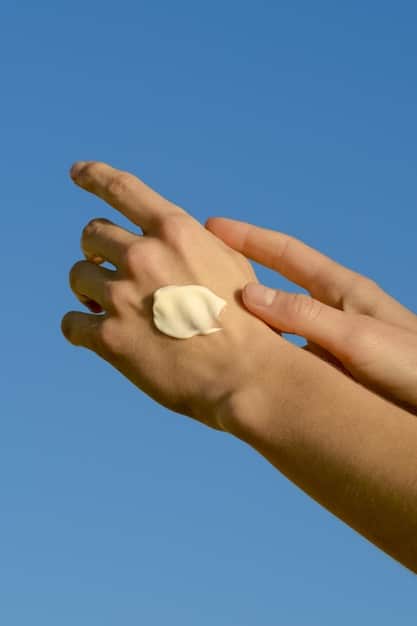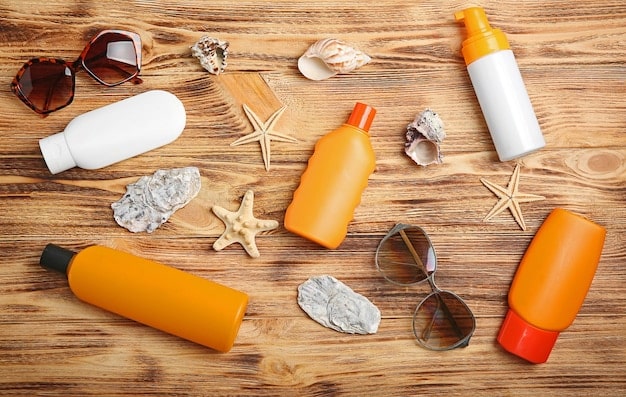Sunscreen Every Day: Your Key to Timeless Skin

Sunscreen every day is a non-negotiable skincare step to prevent premature aging, protecting your skin from harmful UV rays that cause wrinkles, sunspots, and loss of elasticity. Consistent, daily application is vital.
Incorporating sunscreen every day: a skincare routine non-negotiable for preventing premature aging, is the most effective way to protect your skin from sun damage and maintain a youthful complexion. Let’s explore why this step is so crucial.
Why sunscreen is a must in your daily skincare routine
The sun’s UV rays are a primary culprit in premature aging. Incorporating sunscreen into your daily routine is the easiest way to combat this issue.
Sunscreen isn’t just for beach days; daily use protects against cumulative sun damage. Let’s delve into the science behind why wearing sunscreen every day is essential.
The impact of everyday sun exposure
Even on cloudy days, UV rays can penetrate your skin, causing damage that accumulates over time. This leads to visible signs of aging and increased risk of skin issues.
Understanding UV rays: UVA and UVB
UVA rays cause premature aging, while UVB rays cause sunburn. Both contribute to skin damage and increase the risk of skin cancer. Sunscreen protects against both.
- UVA rays: Penetrate deep into the dermis, leading to wrinkles and age spots.
- UVB rays: Primarily affect the skin’s surface, causing sunburn and increasing skin cancer risk.
- Cumulative damage: Daily, unprotected exposure adds up, accelerating the aging process.
Using sunscreen shields your skin from these harmful rays, minimizing the risk of premature aging and protecting overall skin health. Choosing the right sunscreen and using it properly is vital for optimal protection.

Choosing the right sunscreen for your skin type
Selecting the appropriate sunscreen is crucial for ensuring optimal protection and comfort. Different skin types have varying needs, and the right sunscreen can make all the difference.
Consider factors such as SPF level, ingredients, and formulation when choosing a sunscreen. Let’s explore the best options for various skin types.
Understanding SPF and broad spectrum
SPF indicates the level of protection against UVB rays, while “broad spectrum” means the sunscreen protects against both UVA and UVB rays. Choose at least SPF 30 with broad-spectrum protection.
Ingredients to look for and avoid
Look for ingredients like zinc oxide and titanium dioxide for mineral sunscreens. Avoid chemical sunscreens with oxybenzone or octinoxate, which can harm coral reefs and may have hormonal effects.
- Oily skin: Opt for oil-free, non-comedogenic formulations to avoid clogging pores.
- Dry skin: Choose hydrating sunscreens with moisturizing ingredients like hyaluronic acid or glycerin.
- Sensitive skin: Mineral sunscreens are often best, as they are less likely to cause irritation.
- Combination skin: Look for lightweight formulas that balance hydration without causing excess oil.
Proper sunscreen application ensures consistent protection. Apply generously and reapply every two hours, especially after swimming or sweating, so it’s crucial to consider the right one for you that meets your needs and aligns with your lifestyle.
How to apply sunscreen correctly for maximum protection
Applying sunscreen correctly is just as important as choosing the right product. Incorrect application can significantly reduce the effectiveness of the sunscreen.
Ensure every part of your skin is adequately covered for optimal protection from UV rays. Here’s a step-by-step guide to proper sunscreen application.
The right amount: two-finger rule
A general guideline is to use about two tablespoons (or one ounce) of sunscreen to cover your entire body. For the face, use about a teaspoon-sized amount.
When to apply: before going outside
Apply sunscreen 15-30 minutes before sun exposure to allow it to bind to your skin. This timing ensures that sunscreen is fully effective when you step outside.
- Apply generously: Don’t skimp on the amount. Ensure every exposed area is thoroughly covered.
- Reapply frequently: Reapply every two hours, or immediately after swimming or sweating.
- Don’t forget often-missed spots: Include your ears, neck, lips, and tops of your feet.
Regular reapplication is crucial, especially during prolonged sun exposure. Make it a habit to reapply every two hours to maintain optimal protection and prevent sun damage. Consistent and correct application makes this process most effective.
Sunscreen and makeup: creating a seamless routine
Integrating sunscreen into your makeup routine can be tricky, but it’s essential for daily protection. Finding the right balance ensures your skin is protected without compromising your makeup look.
Layering products correctly will help ensure your makeup complements your sunscreen rather than hindering it. Let’s walk through how to effectively merge sunscreen with your makeup.
Sunscreen first: the proper layering technique
Always apply sunscreen as the last step in your skincare routine and before makeup. This placement allows it to effectively shield your skin from UV rays without interference from other products.
Choosing makeup with SPF: added protection
While makeup with SPF can provide some protection, it’s usually not enough. Rely on a dedicated sunscreen for adequate coverage. The SPF in makeup products may not be as effective.
- Primer with SPF: Use a primer with SPF for an extra layer of protection.
- Tinted sunscreen: A great option for light coverage while protecting your skin.
- Setting spray with SPF: Reapply sunscreen throughout the day with a setting spray.
Proper integration of sunscreen into your makeup ensures comprehensive protection without sacrificing your desired look. By following these tips, you can maintain radiant, healthy skin while enjoying your favorite makeup products.

Addressing common sunscreen myths and misconceptions
There are many misconceptions about sunscreen that can lead to inadequate protection. Debunking these myths is crucial for ensuring you get the full benefits of sunscreen.
Let’s clarify some common misconceptions and provide accurate information about sunscreen use. This includes issues about sunscreen, such as people of color not needing to wear sunscreen, darker skin being naturally safe from the sun, and so on.
Myth: Darker skin doesn’t need sunscreen
All skin tones need sunscreen. While darker skin has more melanin, it’s not enough to protect against sun damage. UV rays can still cause wrinkles, hyperpigmentation, and skin cancer.
Myth: Sunscreen is only needed on sunny days
UV rays can penetrate clouds, so sunscreen is necessary even on cloudy days. Consistent daily use is essential to protect your skin from cumulative damage, whether it is sunny or not.
- High SPF provides more protection: SPF 30 blocks about 97% of UVB rays, while SPF 50 blocks about 98%. The difference is minimal, so focus on proper application.
- Sunscreen prevents tanning: While sunscreen reduces the risk of sunburn, you can still tan while wearing it. Tanning is a sign of skin damage.
- Sunscreen is only for summer: UV rays are present year-round, making daily sunscreen use essential.
Adopting a consistently practical and truthful approach to skincare, incorporating sunscreen every day, is crucial for safeguarding your skin from the effects of premature aging and long-term issues.
The long-term anti-aging benefits of daily sunscreen use
Regular sunscreen use offers more than just short-term protection; it provides significant anti-aging benefits over time. This simple habit can dramatically improve your skin’s health and appearance.
Consistent sunscreen use can prevent wrinkles, sunspots, and loss of elasticity. Let’s explore the transformative effects of making sunscreen a daily habit.
Preventing wrinkles and fine lines
Sunscreen helps prevent collagen breakdown caused by UV rays, reducing the appearance of wrinkles and fine lines. Protecting your skin’s collagen structure is vital for maintaining youthful firmness.
Reducing the risk of sunspots and hyperpigmentation
Sunscreen minimizes the formation of sunspots and hyperpigmentation by blocking UV rays that trigger melanin production. This results in a more even and radiant complexion. Additionally, using a Vitamin C serum can help reduce hyperpigmentation from occurring, as well.
- Maintaining skin elasticity: Prevents the breakdown of elastin, keeping skin firm and supple.
- Protecting against skin cancer: Significantly reduces the risk of developing skin cancer.
- Improving skin tone: Prevents uneven skin tone and discoloration.
By shielding your skin from UV damage, you’re investing in its long-term health and vitality. Daily sunscreen is an investment in your long-term appearance and well-being. Using sunscreen every day helps prevent premature aging that comes with damage from the sun.
| Key Point | Brief Description |
|---|---|
| ☀️ Daily Protection | Shields skin from harmful UV rays every day. |
| 🛡️ Anti-Aging | Prevents wrinkles, sunspots, and loss of elasticity. |
| 🧴 Correct Application | Apply generously and reapply every two hours. |
| ✅ All Skin Tones | Essential for all skin types, regardless of color. |
[FAQ About Sunscreen]
▼
Aim for at least SPF 30 for daily use. It blocks about 97% of UVB rays. Higher SPFs offer marginally more protection, but proper application is most important.
▼
No, UV rays can penetrate clouds, so sunscreen is essential even on cloudy days. Consistent daily use protects against cumulative damage regardless of the weather.
▼
Reapply sunscreen every two hours, or immediately after swimming or sweating. Regular reapplication ensures continuous protection, especially during prolonged sun exposure.
▼
Mineral sunscreens (zinc oxide, titanium dioxide) are generally better for sensitive skin as they are less likely to cause irritation. Choose what works best for your skin type.
▼
Makeup with SPF can provide some protection, but it’s usually not enough. Rely on a dedicated sunscreen for adequate coverage. Ensure it’s a broad spectrum SPF to provide adequate protection for your skin.
Conclusion
Making sunscreen every day: a skincare routine non-negotiable for preventing premature aging, is the cornerstone of a healthy skincare regimen. By understanding its importance, choosing the right product, applying it correctly, and debunking common myths, you can protect your skin from sun damage and maintain a youthful, radiant complexion for years to come.





